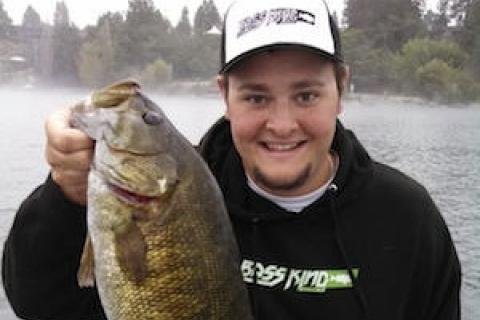
 To consistently catch bass no matter what the season, you must have an understanding of what type of baitfish the bass are feeding on and what the water temperature does to the behavior of those specific species. This changes as the weather changes, and one important rule to remember is if you find the bait, you will find the bass.
To consistently catch bass no matter what the season, you must have an understanding of what type of baitfish the bass are feeding on and what the water temperature does to the behavior of those specific species. This changes as the weather changes, and one important rule to remember is if you find the bait, you will find the bass.
In the fall of the year, the baitfish of choice for the majority of bass around the country is the abundant populations of shad. The reason for that is simple: Every fall, the majority of the shad make their annual movement into shallow-water creeks and pockets. The bass will be close behind and will really key in on this opportunity to corner the bait in shallow water situations. When looking for shad, I like to check the backs of major creeks as well as pockets. I like to idle into the area and visibly look for balls of shad disturbing the waters surface, which in calm conditions are easy to see. Now if the wind is blowing and the water is choppy, then this visual searching is not possible, and in that case a good Lawrance HDS 8 Graph can allow you to find the bait no matter what the conditions.
Once you've found the shad, there are a few baits that you need to have in your boat when targeting fall shad-eating bass. The first and probably one of the best fish-catching baits ever invented is the spinnerbait. The type of spinnerbait I like to use varies from season to season. In the fall when I'm trying to imitate the shad, I like to use a small- to medium-size bait in some sort of natural white or shad-looking color. Which blades you choose is also very important, and to imitate the shad I always use silver blades.
Which size blades depend on what size of shad I see while fishing. I always like to pay attention to the size of the bait I see while fishing. If the majority of the shad are small, then I use small blades; if I see large shad, then I will use large blades. If you notice that the shad are small, then a 1/8oz Stanley Wedge Plus in a firecracker or white color is a great choice. If the shad are big, then use a larger ⅜- or 1/2-ounce bait.
One very important thing to always remember when deciding to use a spinnerbait is whether or not the wind is blowing. When the wind is blowing, a spinnerbait is hard to beat. Look for pockets with shad, and fish the windiest corners of the pocket and have a blast catching some very aggressive bass.
Another rig that possibly is even more effective than the spinnerbait is the umbrella rig. The original model of this style of rig is called the Alabama rig, made by Mann’s bait company. The rig hit the market two years ago and has quickly become one of the very most effective fish catchers on the market today.
I like to fish my rig with five of the Bass Pro Shops Boss Shads. These swimbaits come pre-rigged with the jighead and hook built into the plastic, and are a very effective, affordable way to set up your rig. All you have to do is figure out which depth the bass are feeding at, and reel your rig through the school. These rigs draw explosive strikes, with the bass crashing through the ball of shad. Don't be surprised to catch multiple fish on a single cast when using the deadly five. I have personally caught three spotted bass on one cast as well as catching a 15-lb. striper, a 1.5-lb spot, and a 1.5-lb. largemouth all on one cast. I promise you, this is a fun way to fish.
Some other great shad imitators are crankbaits, jerkbaits and topwater baits – these all will catch fish in the fall of the year. The size and style of bait I use again relates to the size of the baitfish. One of my favorite fall crankbaits is the Spro Little John MD. This is a small bait that will still dive to depths around 8 feet, which is perfect for catching bass that are targeting shad in shallow water. I generally will go with a Spro McStick, and for my topwater I like a Spro Dawg that with a twitch of the wrist will effortlessly walk across the surface of the water.
All the baits I have talked about are reaction baits. They are designed to be moved fast and induce a quick reaction strike, which is very effective on aggressive bass. Always remember that these reaction baits don't always work and you need to keep an open mind and understand when to switch it up to a slower moving technique. My hope is that this information will put more fish in your boat. I'll see you on the water!!!
by Joey Nania
- 4287 views

